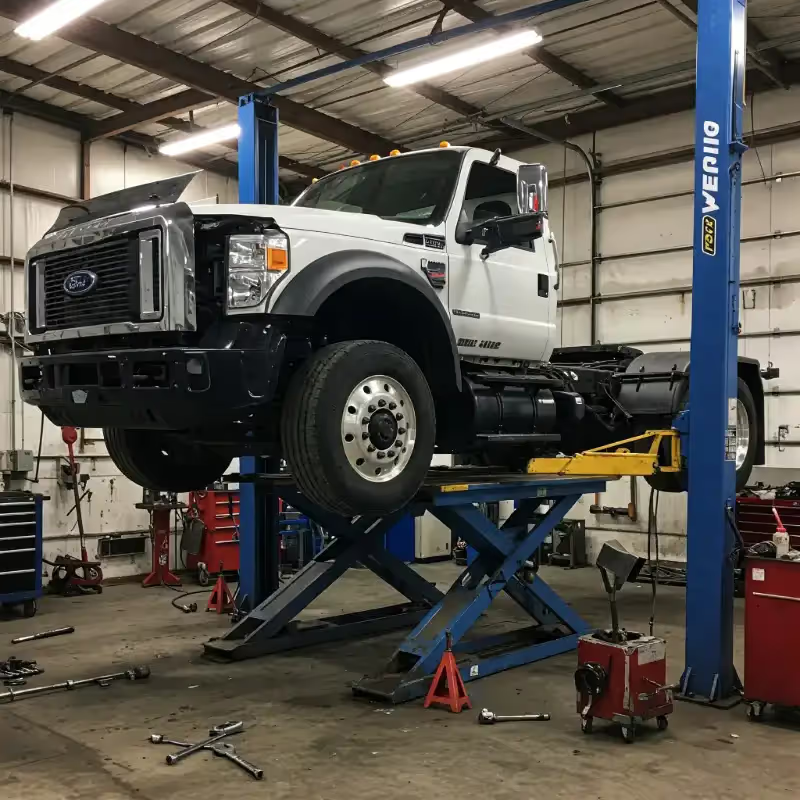Why Arizona Roads Are So Hard on Diesel Trucks
Arizona’s harsh climate and rugged terrain wreak havoc on diesel trucks. From triple-digit heat and steep mountain climbs to dusty air and rough roads, every part of your rig takes a beating. Discover why diesel engines struggle here—and how smart maintenance keeps you moving.

Arizona isn’t kind to your diesel truck. Between the blistering heat, rugged terrain, and long-haul demands, it’s no wonder trucks in the Grand Canyon State need repairs more often. If you’ve ever driven I-10 in the middle of July or hauled a heavy load up to Mount Lemmon, you already know: Arizona roads don’t play fair.
But why exactly are these roads so brutal on diesel-powered rigs? Let’s break it down, piece by piece.
Scorching Temperatures & Cooling System Strain
Arizona summers are infamous. When temperatures flirt with 115°F or higher, your engine cooling system goes into overdrive. Diesel engines naturally run hotter than gas engines, and their coolant systems—radiators, thermostats, water pumps—must work nonstop to keep temps under control.
Now throw in stop-and-go traffic in Tucson or a steep incline out of Bisbee, and you’ve got the perfect storm for overheating, especially if:
- Your fan clutch isn’t engaging properly
- The radiator is clogged or full of scale
- The coolant mix isn’t up to spec
In extreme heat, even a small failure can cause a domino effect that leads to cracked heads, warped manifolds, or blown head gaskets
Mountain Grades & Drivetrain Fatigue
Arizona’s landscape isn’t all flat desert. From the Mogollon Rim to the Chiricahua Mountains, you’re constantly switching from lowlands to high elevations.
Climbing those grades means constant gear changes, heavy throttle, and maximum torque output. Your transmission, differentials, and drive shafts all take a beating—especially when:
- Hauling freight up steep inclines
- Running with worn-out gear oil
- Skipping driveline maintenance
Over time, that kind of abuse wears out u-joints, overheats differentials, and can cause slipping transmissions if fluid levels drop or degrade.
Dust, Dirt, and Desert Debris
Arizona's desert is extremely dusty, and that fine grit gets everywhere.
From the copper mines near Morenci to open stretches near Benson, air filters, fuel filters, and intake systems are under constant assault. That dust can:
- Clogged air filters reducing combustion efficiency
- Contaminated diesel fuel, damaging injectors
- Cause abrasion inside turbos and cylinders
If you're not running a tight PM schedule, it’s easy for fuel economy to tank and power output to drop off a cliff.
Rough Roads and Suspension Wear
Whether it’s cracked pavement, cattle guards, or just plain old washboard roads, Arizona is full of rough riding. That’s where your suspension system takes the hit.
Leaf springs, shock absorbers, and air suspension components all work overtime trying to maintain ride height and control rebound movement. Common issues include:
- Broken or fatigued leaf springs
- Leaking or unresponsive shocks
- Air bags losing pressure or tearing
Poor suspension doesn’t just rattle your cab—it affects handling, tire wear, and puts extra stress on the frame.
Elevation Changes and Turbo Trouble
One minute, you’re cruising near sea level in Yuma. Next, you’re 7,000 feet up in Flagstaff. That rapid elevation change plays havoc with your turbocharger and exhaust system.
Thin air reduces combustion efficiency, forcing your ECM (engine control module) to adjust fuel-air ratios. If your turbo isn’t in top shape, or your aftertreatment system (DPF, EGR, SCR) is clogged, your truck may:
- Struggle with power loss
- Kick up regen cycles more frequently
- Show check engine lights due to NOx sensor faults
Arizona’s altitude shifts can amplify any underlying issue, especially when you’re already dealing with heat or heavy loads.
Extended Hauls Across Remote Terrain
Driving through Arizona often means long stretches with no services in sight—looking at you, I-8. That puts roadside assistance to the test.
A blown coolant hose, failed alternator, or fuel pump malfunction 50 miles from anywhere? You’ll wish you’d kept up with preventive maintenance. Arizona roads demand:
- Frequent fluid checks (especially coolant and oil)
- Vigilant tire inspections
- Routine battery and electrical system tests
Trust us, there’s nothing like watching your dash light up as your DEF system fails in the middle of nowhere.
The Bottom Line? Arizona Doesn’t Cut Diesel Trucks Any Slack
You’ve got triple-digit temps, mountainous climbs, rough roads, and dry, dusty air—all working together to wear down your truck faster than most other states.
Arizona roads expose every weakness in your diesel truck. From the engine cooling system to the suspension, air filters, and aftertreatment components, there’s no margin for error.
Practical Advice to Protect Your Rig
So what can you do to keep your truck in fighting shape on Arizona’s roads?
- Stick to a rigorous PM schedule—don’t skip your intervals.
- Upgrade your cooling system if you’re hauling heavy in summer.
- Invest in high-quality air filtration—especially during monsoon season.
- Keep an eye on driveline components, especially if you’re hitting mountain passes often.
- Use Arizona-ready coolant and monitor regen cycles closely.
- Partner with an Arizona-based heavy-duty repair shop that knows the roads like the back of its hand
Conclusion
Arizona roads will chew up a neglected diesel truck and spit it out. But with a little preparation, proper maintenance, and an understanding of the unique conditions you’re up against, you can stay ahead of breakdowns and avoid getting stranded in the heat.
More Articles
Contact Elite Sales & Service
Elite Sales & Service provides professional mobile truck repair & fleet services in Benson, Arizona & a 150 mobile service radius. Contact us today with any questions, to request a quote, and to schedule service.
.avif)

